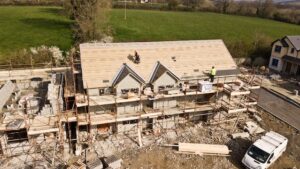As we bask in the glorious rays of sunshine, let’s take a moment to ponder on something often overlooked – our roofs. Yes, those sturdy guardians above our heads are constantly battling against the relentless onslaught of ultraviolet (UV) radiation. And while we soak up vitamin D and enjoy outdoor adventures, it’s only fair that we give some much-needed attention to protecting our rooftops from the harmful effects of the sun.
Today, we’ll unravel the secrets to safeguarding your roof from UV damage. From choosing UV-resistant materials to applying reflective coatings and maintaining proper ventilation – together, let’s ensure that your roof remains strong, resilient, and ready for any weather conditions Mother Nature throws its way.
Use UV-Resistant Roofing Materials
 Opting for UV-resistant roofing materials can make a world of difference in prolonging your roof’s lifespan and preventing costly repairs down the line. One popular option is asphalt shingles with built-in UV inhibitors. These specially formulated shingles help block harmful radiation and prevent premature deterioration. Additionally, metal roofs are known for their excellent resistance to UV damage due to their reflective properties.
Opting for UV-resistant roofing materials can make a world of difference in prolonging your roof’s lifespan and preventing costly repairs down the line. One popular option is asphalt shingles with built-in UV inhibitors. These specially formulated shingles help block harmful radiation and prevent premature deterioration. Additionally, metal roofs are known for their excellent resistance to UV damage due to their reflective properties.
If you’re considering alternative options, synthetic roofing materials like composite or rubber shakes are worth exploring. They offer superior UV protection while mimicking the look of traditional wood or slate without the susceptibility to sun damage. Just be sure to hire this top twin city roofing contractor to install them.
Apply Reflective Roof Coatings
When it comes to protecting your roof from the damaging effects of UV rays, applying reflective roof coatings can be a game-changer. These coatings are tailor-made and designed to completely reflect sunlight and heat miles away from your roof, helping to reduce the temperature and minimize potential damage. The best thing about using reflective roof coatings is that they can significantly cut down energy costs by reducing the need for air conditioning. By keeping your roof cooler, these coatings help maintain a more comfortable temperature inside your home without relying solely on mechanical cooling systems.

Install Adequate Ventilation
Without adequate airflow, heat can become trapped in the attic area of your home, leading to a range of issues, including accelerated UV damage. One way to ensure proper ventilation is by installing soffit vents at the eaves and ridge vents at the peak of your roof. This allows air to enter through the soffits and exit through the ridge, creating a natural flow that helps regulate temperatures. Additionally, you may consider adding gable vents or turbine vents for extra airflow. These types of vents can help release hot air from within your attic during those scorching summer months. Installing adequate ventilation not only helps combat UV damage but also contributes to better energy efficiency by keeping your home cooler during those sweltering summers.
Regular Roof Inspections and Maintenance
 Scheduling regular roof inspections allows you to identify any issues early on, including cracks, leaks, or damaged shingles. During these inspections, a professional roofer will carefully assess all aspects of your roof, including its structure, flashing, gutters, and ventilation system. After identifying any issues during the inspection process, it’s important to address them promptly through regular maintenance. This may involve repairing damaged areas or replacing worn-out materials to prevent further deterioration.
Scheduling regular roof inspections allows you to identify any issues early on, including cracks, leaks, or damaged shingles. During these inspections, a professional roofer will carefully assess all aspects of your roof, including its structure, flashing, gutters, and ventilation system. After identifying any issues during the inspection process, it’s important to address them promptly through regular maintenance. This may involve repairing damaged areas or replacing worn-out materials to prevent further deterioration.
Protecting your roof from UV damage is crucial for its longevity and performance. So don’t let those ultraviolet rays take a toll on your roof’s health; fight back with these strategies! Your roof will thank you for it as it continues to shield you from all types of weather conditions for years to come.
Comments are closed